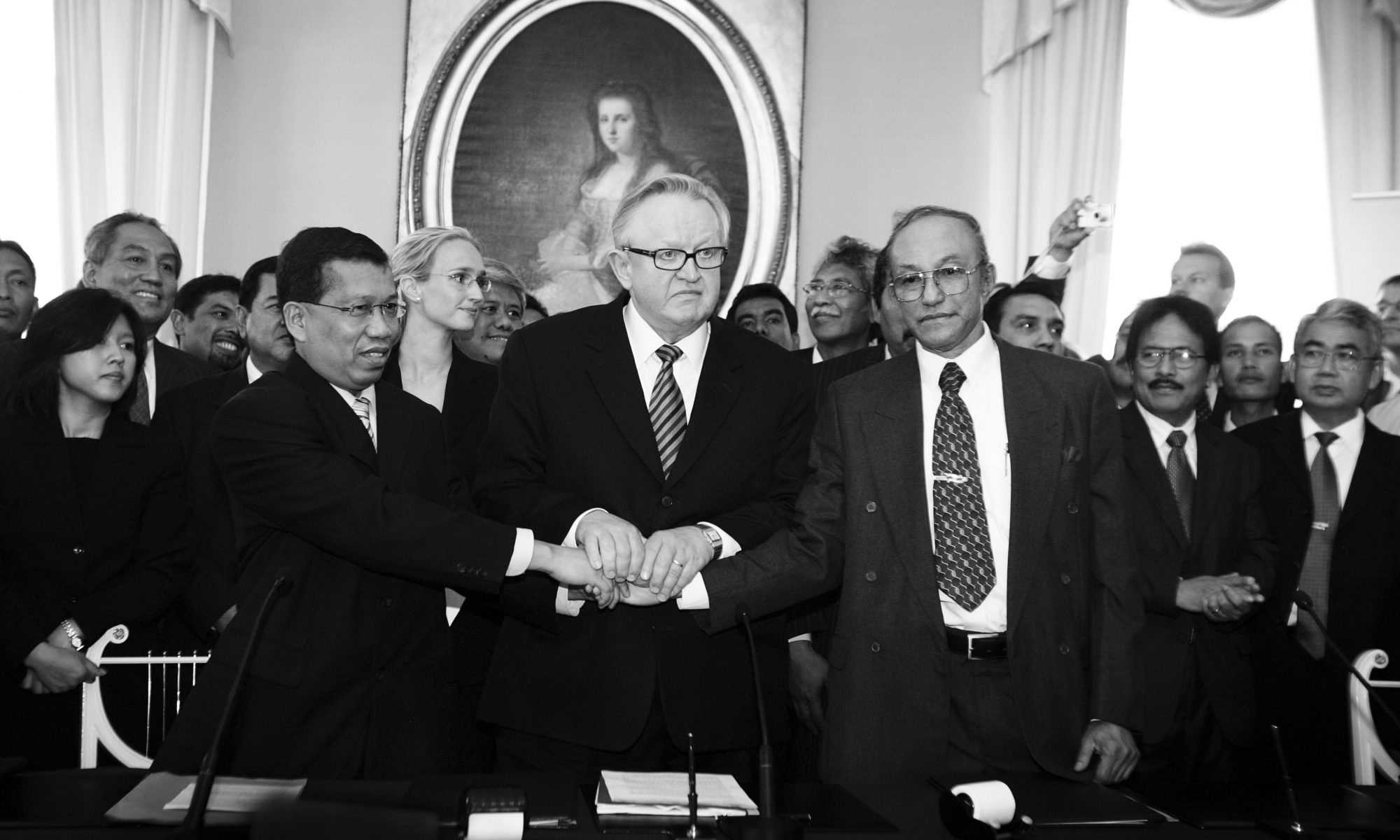(tekstiä editoitu 18.9. klo 22:30 lisäämällä maininta Wallströmin ja Soinin Vieraskynä-kirjoituksesta HS:ssa 12.9.
Feministinen hyvinvointivaltiopolitiikka ja valtioiden harjoittama tasa-arvopolitiikka ovat kriisissä, tai ainakin talouskriisin ratkaisuyrityksiin liittyvien leikkausten välikappaleena ja uudenlaisen oikeistolaisen politiikan työkalu.
Samaan aikaan kuitenkin feminismi on nyt ”in” ulko- ja turvallisuuspolitiikassa: Margot Wallströmin lanseeraama feministinen ulkopolitiikka kuohuttaa ja kiinnostaa kansainvälisesti. Wallströmin esiintyessä yhdessä ulkoministeri Soinin kanssa kieli kuitenkin muuttuu: feminismin tilalle tulee sukupuolten välinen tasa-arvo.
Toisaalta Pohjoismaissa on syntynyt uusia feminismille sitoutuneita puolueita, esimerkkeinä Ruotsin Feminiskt Initiativ ja Suomessa kesällä 2016 kannattajakorttien keräämisen ja kuntavaalitavoitteet asettanut feministinen puolue.Feminististä puoluetta on jo ehditty kiitellä siitä, että sen synnyttäminen tullee merkitsemään poliittisen keskustelun sähköistymistä. Vanhat puolueet eivät halua jäädä feminismissään jalkoihin.
Feministisen puolueen perustavan kokouksen jälkeen feminismiin tarttuivat nyt syyskuussa Vihreät, joka julkaisi 18.9. ulko- ja turvallisuuspoliittisen linjapaperinsa valtuuskunnan kokouksessa Tikkurilassa, Vantaalla. Mitä Vihreät feministisellä turvallisuuspolitiikalla tarkoittavat ja millaisin keinoin sitä halutaan ajaa?
Helsingin Sanomien artikkelin jälkeen jäin pohtimaan, nouseeko feminismi turpo-linjauksen läpileikkaavaksi teemaksi, vai yhtyykö Vihreät –puolue ’maan tapaan’ (s.35), jossa feminismi ulko- ja turvallisuuspolitiikassa, tosin usein sitä lainkaan feminismiksi nimeämättä, rajataan naisten oikeuksien ja tasa-arvon edistämiseen kehitysyhteistyössä ja YK:n turvallisuusneuvoston päätöslauselman 1325 (ns. naiset, rauha ja turvallisuus –päätöslauselma) toteuttamisena Suomen ulkosuhteissa ja osana Suomen maabrändin luomista.
Vihreiden turvallisuuspoliittinen linjapaperi on jaettu seitsemään osioon, joista ”Suomi rauhan rakentajana: feminististä turvallisuuspolitiikkaa” on kuudes. Muut linjauksen otsikkotason teemat ovat: Euroopan unioni, yhteistyö Ruotsin kanssa, Venäjä, kyberturvallisuus ja tiedustelu, Arktinen alue ja aseriisunta.
Johdanto tekee lupaavan avauksen: laaja turvallisuuskäsite ja kansainväliset oikeudet nostetaan Vihreiden turvallisuus- ja puolustuspolitiikan keskiöön. Laaja turvallisuuskäsite ei sinänsä tuo mitään uutta viime vuosikymmeninä käytyyn suomalaiseen keskusteluun. Tätä keskustelua on kuitenkin kritisoitu, kansainvälisesti, feministisen turvallisuustutkimuksen piirissä sukupuolisokeaksi. Nostamalla feministisen turvallisuuspolitiikan linjauksensa yhdeksi avainteemoista, Vihreät tekevätkin uuden avauksen turvallisuuspoliittiselle keskustelulle.
Vihreiden linjaus ei kuitenkaan valtavirtaista feminismiä koko turvallisuuspolitiikan perustaksi, vaan feminismi rajataan koskemaan suomalaista maabrändiä rauhanrakentajana. Vaikka linjaus toteaakin, että turvallisuuspolitiikan keskiöön on nostettava rakenteellinen ja sukupuolittunut väkivalta – nämä periaatteet rajataan koskettamaan rauhanvälitystä, kriisinhallintaa ja kehitysyhteistyötä. Ainoa linjauksessa mainittu Suomea koskeva rakenteellinen sukupuolisyrjinnän muoto on yhdelle sukupuolelle pakollinen asevelvollisuus.
Myönnän, että petyin. Oma odotukseni nimittäin oli, että feministinen turvallisuuspolitiikka noudattelisi feministinen turvallisuuspolitiikan tutkimuksen jo vuosikymmeniä esille tuomia teemoja: sukupuolittuneen väkivallan tai esim. useamman CEDAW-komitean raportin esittämän huolen maahanmuuttajanaisten kohtaamasta moniperustaisesta syrjinnästä erityisesti terveydenhuollon, koulutuksen ja työllistymisen kysymyksissä.
Myöskään Sipilän hallituksen tekemät turvapaikka- ja maahanmuuttoa rajoittavat lait ja päätökset (esim. perheenyhdistämislaki) tai ihmiskaupan ja turvapaikkapolitiikan kytkökset eivät näyttäydy linjaukseen sisältyvinä kysymyksinä.
Vihreiden tekemä avaus feministisestä turvallisuuspolitiikasta tuotti pettymyksen. Linjaus ei ota kantaa nyky-hallituksen linjauksiin, joilla on merkittäviä vaikutuksia laajan turvallisuuden, sukupuolten tasa-arvon ja yhdenvertaisuuden, toteutumiselle. Seuraavaksi katseeni kääntyy feministisen puolueen ulko- ja turvallisuuspoliittisiin linjauksiin. Sparraajaa tarvitaan edelleen.
Lisäluettavaa:
Jauhola, Marjaana (2016)“Decolonizing branded peacebuilding: abjected women talk back to the Finnish Women, Peace and Security Agenda“, International Affairs 92(2), 333-351.
Jauhola, Marjaana and Kantola, Johanna (2016). “Globaali sukupuolipolitiikka Suomessa” (in Finnish) in Husso, Marita and Heiskala, Risto (eds.) Sukupuolikysymys. Helsinki: Gaudeamus, 187-208.
Jauhola, Marjaana (2015) Feminismiä 1+364: Feministisen ulkopolitiikan välttämättömyydestä, Politiikasta.fi 9.3.2015
Jauhola, Marjaana (2015) Helsingin rauhanneuvottelujen toiset kasvot – Aceh 10 vuotta myöhemmin, Politiikasta.fi 13.8.2015
Jauhola, Marjaana (2012) Tasa-arvosta Suomen vientituote? Suomalainen tasa-arvopuhe erojen tuottajana teoksessa “Suomalaisen politiikan murroksia ja muutoksia” Kari Paakkunainen (toim.). Politiikan ja talouden tutkimuksen laitoksen julkaisuja 2012:1, Helsinki.
Jauhola, Marjaana (2002) Sillanrakentajia – naiset konflikteja ehkäisemässä Helsinki: Kansalaisten turvallisuusneuvosto (KATU).



